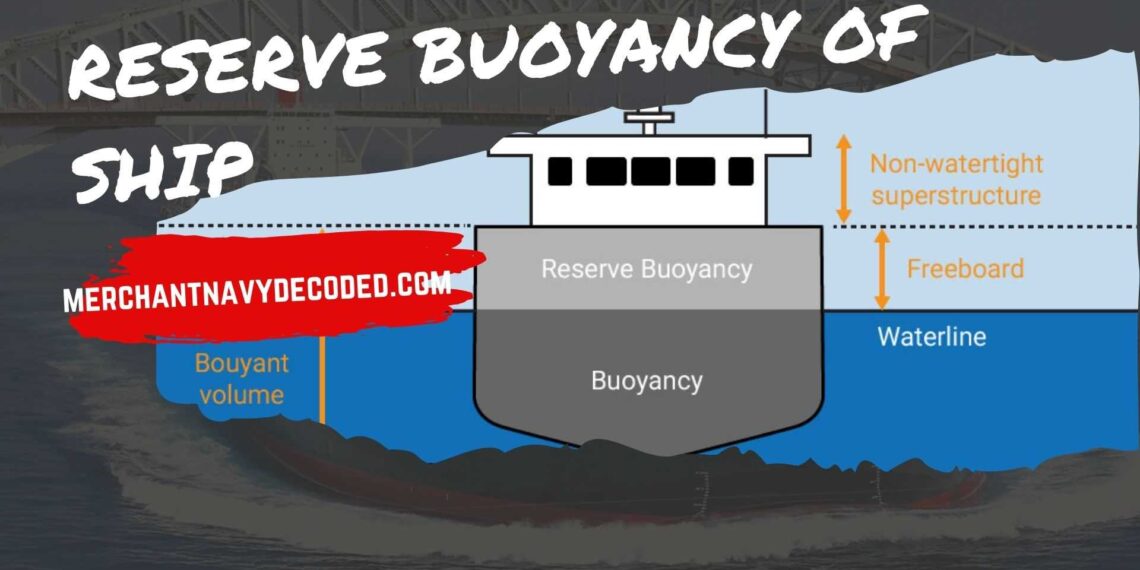Reserve Buoyancy and TPC of Ship
Table of contents
Overview
TPC is a term commonly used in the maritime industry. It refers to the maximum weight of cargo that a vessel can carry in freshwater while maintaining the required stability and safety levels.
Reserve buoyancy refers to the volume of a ship’s hull that remains above the waterline when the vessel is fully loaded or partially submerged.
1. What is TPC

TPC is the number of tonnes required to cause the ship to sink or rise by one centimetre. In SI units TPC is indicated as t/cm.
Considering 1 cm sinkage
Increase in underwater volume = (A * (1/100)) m^3
Increase in W = (A/100) * density of water displaced
Or TPC = (A/100) * density of water displaced
The TPC in salt water (SW) = (A/100) * 1.025
TPC in freshwater (FW) = (A/100) * 1.000 = A/100
TPC in DW RD 1.017 = (A/100) * 1.017 = 1.017A/100
Where A is the waterplane area.

We assume that the water-plane area remains constant, especially when we’re dealing with small changes in the draft, like just a few centimetres. This assumption simplifies the calculations. But in reality, as the ship’s draft increases, so does its water-plane area and its TPC.
Therefore, if we want accurate calculations for the ship’s TPC, especially as the draft changes significantly, we need to consider this increase in the water-plane area. But to keep things manageable and accurate, we usually limit our calculations to small changes in the draft, typically less than about 20 centimetres. Beyond this, the accuracy of our calculations might suffer because we’re not considering the changing water-plane area.
In the case of a box-shaped vessel, the area of the water plane is the same at all drafts and hence its TPC does not change with draft.
TPC tells us how much weight a ship can carry for every inch it sinks into the water. This helps ship operators know how much cargo they can load onto the ship without making it too heavy or unstable.
2. Reserve Buoyancy

It refers to the amount of enclosed space present above the water line. It may be expressed as a volume in m^3 or as a percentage of the volume of the ship.
Reserved buoyancy = Total volume – underwater volume
Reserve Buoyancy % = (Above water volume * 100)/100

Reserve buoyancy in a boat is like having extra room for water to be displaced if something heavy is added to the boat or if water accidentally gets inside the boat. It’s like a safety cushion that helps keep the boat afloat even in unexpected situations like if the boat gets damaged underwater and water starts coming in. So, even though the boat might not be using that extra buoyancy right now, it’s there just in case it’s needed to stay afloat.
Reserve buoyancy is like having a backup plan. It’s the extra ability of a ship to stay afloat even if something unexpected happens like water getting inside the ship or extra weight being added. This extra buoyancy helps prevent accidents like sinking or tipping over.
Conclusion
By understanding and managing TPC and reserve buoyancy, ship designers and operators can make sure ships are loaded correctly, stay stable in rough seas, and are less likely to encounter problems while at sea. This makes voyages safer and more efficient for everyone involved.
Explore the Oily Water Separator: Construction, Working, and Principle. Click Here
Frequently Asked Question
What is the full form of TPC?
TPC stands for tonnes per centimetre.
What do you mean by TPC?
TPC is the number of tonnes required to cause the ship to sink or rise by one centimetre. In SI units TPC is indicated as t/cm.
What is the TPC value of a ship?
The TPC value of a ship states what amount of weight in tonnes is required to sink a ship by the depth of 1 CM.
What is the buoyancy of a ship?
Buoyancy is the force that supports things in a liquid or gas. When a vessel is afloat in calm waters, the water pressure beneath its surface exerts an upward force, generating buoyancy.
What is the reserve buoyancy of a vessel?
The watertight volume of a vessel above the designed waterline is expressed as a percentage of the total buoyancy (volume).
How do ships maintain buoyancy?
As a vessel travels, it displaces this water, and all the while water rushes to fill the space created by the ship. This generates the buoyant force necessary to keep a ship afloat during movement.
Disclaimer :- The opinions expressed in this article belong solely to the author and may not necessarily reflect those of Merchant Navy Decoded. We cannot guarantee the accuracy of the information provided and disclaim any responsibility for it. Data and visuals used are sourced from publicly available information and may not be authenticated by any regulatory body. Reviews and comments appearing on our blogs represent the opinions of individuals and do not necessarily reflect the views of Merchant Navy Decoded. We are not responsible for any loss or damage resulting from reliance on these reviews or comments.
Reproduction, copying, sharing, or use of the article or images in any form is strictly prohibited without prior permission from both the author and Merchant Navy Decoded.



